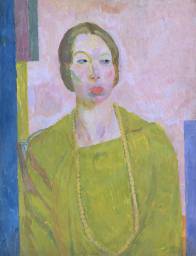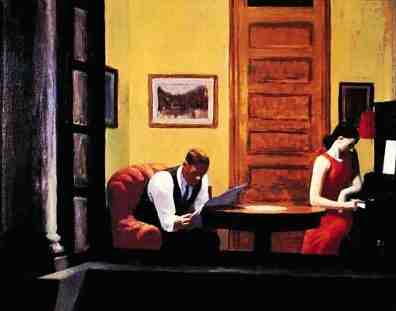A review in the TLS of a new edition of Aldous Huxley’s letters devotes special attention to the author’s complicated relationship with Mary Hutchinson, noting:

What was kept a close secret was that the [Huxley] marriage went through a long period during which both Maria and Aldous were sexually involved with Mary Hutchinson – a writer, married to a barrister. She was also, but less discreetly, a mistress of Clive Bell’s. (An unflattering portrait of her by Bell’s wife, Vanessa, is now in the Tate.)
Emphasis is mine; the “unflattering portrait” is the sour, lemony one shown here. The Tate’s display caption for the painting reads in part, “This portrait shows the short-story writer Mary Hutchinson. She was the mistress of Bell’s husband Clive, a fact of which Bell was aware. This may account for the unflattering nature of the portrait. When it was exhibited, to the sitter’s consternation, Vanessa Bell wrote ‘It’s perfectly hideous… and yet quite recognisable.'”
Image taken from the Tate’s website. © Estate of Vanessa Bell.

 What happened to William Inge? Between 1950 and 1957 he racked up a stunning track record on Broadway–four plays, four hits–and all of his theatrical successes were turned into big-budget Hollywood movies with blue-chip casts. (“Bus Stop” starred Marilyn Monroe, while the Pulitzer-winning “Picnic” featured William Holden and Kim Novak.) For a time critics ranked him right behind Arthur Miller and Tennessee Williams. But Inge lost his sureness of touch as the buttoned-down ’50s gave way to the unsettled ’60s, and after a string of flops, he fled to California to teach and drink, dying by his own hand in 1973. Unlike his more celebrated colleagues, he then vanished down the memory hole, and except for a pair of failed revivals of “Bus Stop” and “Picnic” in the mid-’90s, none of his plays has been seen on Broadway since 1975. Thus it is very big news indeed that “Come Back, Little Sheba” has just been revived on Broadway for the first time since the original production opened there 57 years ago–and that this deeply moving revival, which stars S. Epatha Merkerson of “Law & Order,” is pitch-perfect from curtain to curtain.
What happened to William Inge? Between 1950 and 1957 he racked up a stunning track record on Broadway–four plays, four hits–and all of his theatrical successes were turned into big-budget Hollywood movies with blue-chip casts. (“Bus Stop” starred Marilyn Monroe, while the Pulitzer-winning “Picnic” featured William Holden and Kim Novak.) For a time critics ranked him right behind Arthur Miller and Tennessee Williams. But Inge lost his sureness of touch as the buttoned-down ’50s gave way to the unsettled ’60s, and after a string of flops, he fled to California to teach and drink, dying by his own hand in 1973. Unlike his more celebrated colleagues, he then vanished down the memory hole, and except for a pair of failed revivals of “Bus Stop” and “Picnic” in the mid-’90s, none of his plays has been seen on Broadway since 1975. Thus it is very big news indeed that “Come Back, Little Sheba” has just been revived on Broadway for the first time since the original production opened there 57 years ago–and that this deeply moving revival, which stars S. Epatha Merkerson of “Law & Order,” is pitch-perfect from curtain to curtain. A good staging can’t save a bad play, but it can paper over the cracks in a creaky one, so I want to start off by saying that “Come Back, Little Sheba” is close to flawless. I’d never seen it on stage prior to this revival, and I had no idea what a wallop it packed. It is, like all of Inge’s major plays, a tale of disappointment and frustration set against a shabby, penny-plain backdrop of ordinary middle-class life–you might be watching an Edward Hopper painting come to life–and much of its impact arises from the patience with which the author deals his thematic cards, waiting until just the right moment to throw down his hand and fill the stage with pain and sorrow….
A good staging can’t save a bad play, but it can paper over the cracks in a creaky one, so I want to start off by saying that “Come Back, Little Sheba” is close to flawless. I’d never seen it on stage prior to this revival, and I had no idea what a wallop it packed. It is, like all of Inge’s major plays, a tale of disappointment and frustration set against a shabby, penny-plain backdrop of ordinary middle-class life–you might be watching an Edward Hopper painting come to life–and much of its impact arises from the patience with which the author deals his thematic cards, waiting until just the right moment to throw down his hand and fill the stage with pain and sorrow….